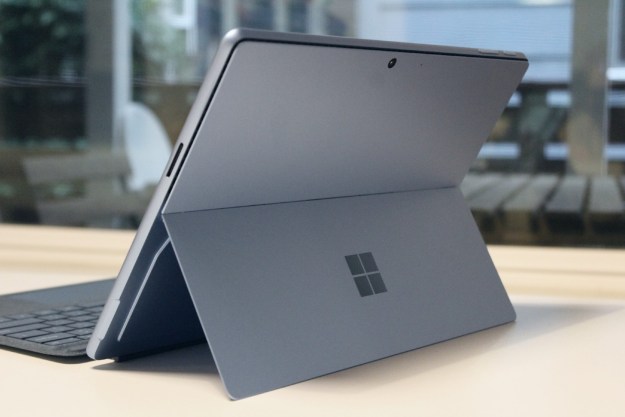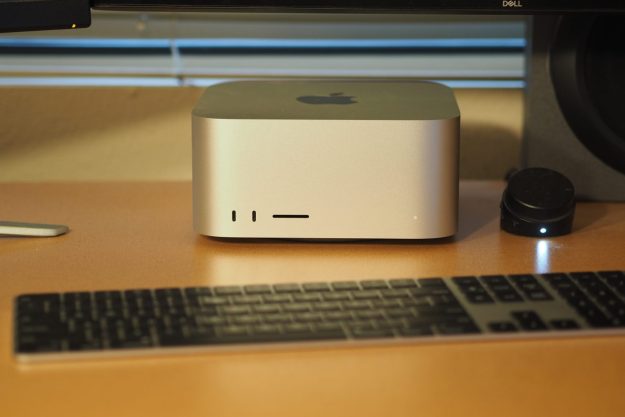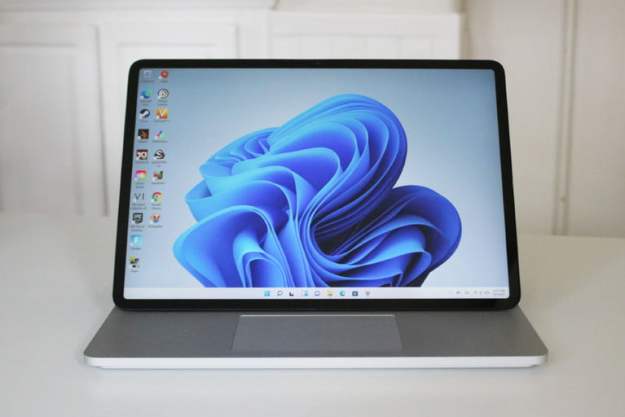
- Most powerful Surface PC
- Gorgeous, 120Hz screen
- Fun 2-in-1 design
- Wonderful haptic touchpad
- Excellent build quality
- CPU holds back performance
Surface devices play by their own rules. They balk at convention. They push the limits.
That sometimes results in products that favor form over function, or others that fall on their face altogether.
The Surface Laptop Studio could have easily been another one of these stumbles. To my delight, Microsoft expertly balances the need for a high-performance laptop with the adventurous design the Surface devices are known for. As an alternative to the Dell XPS 15 or MacBook Pro, the Surface Laptop Studio has its strengths and weaknesses. But taken at face value, as a device that delivers a completely unique PC experience, it’s a winner.
Design
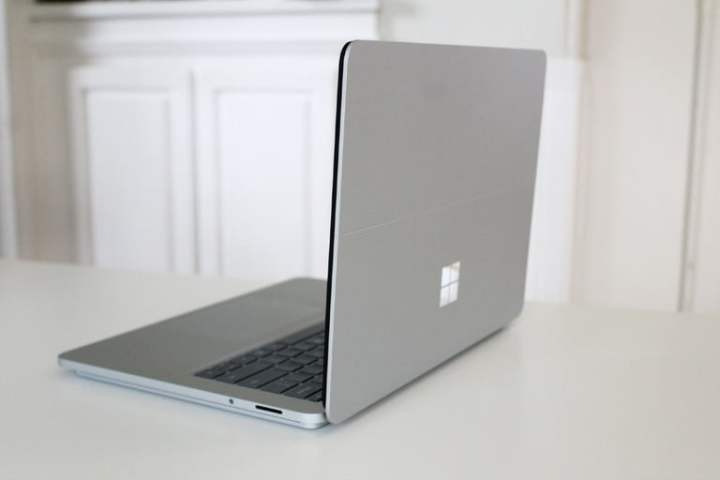
From afar, the Surface Laptop Studio looks fairly conventional. It’s a silver, 14-inch laptop with a Microsoft logo on the lid. Big deal, right?
Then, your eyes are drawn to the vents along the sidewalls of the laptop. Next, you see the fold in the back of the lid. By the time you’re pulling the screen forward over the keyboard, it dawns on you that this is no orthodox laptop.
The base of the laptop is cut in half and made from two pieces — one with ports that hangs over the side and one lined with open vents. It’s unlike anything I’ve seen in a laptop design before.
It’s rare to see this amount of airflow on a premium laptop like this in general. Laptop manufacturers tend to prefer a simpler design with less visible openings. The MacBook Pro and Dell XPS 15 are both examples of this philosophy.
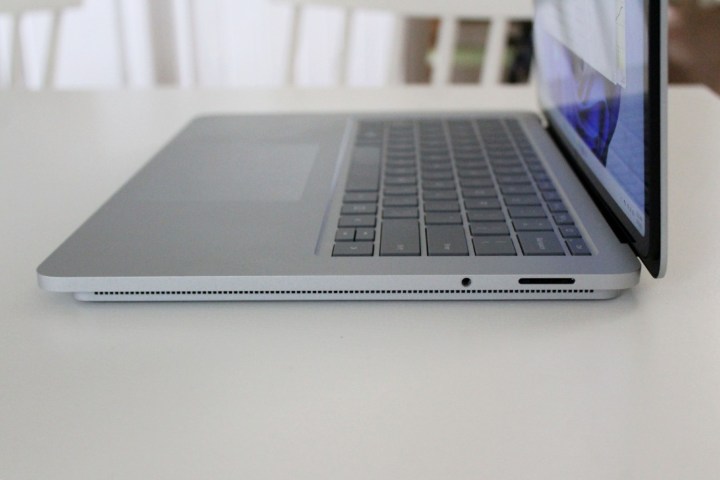
But the Surface Laptop Studio gets to bake its cake and eat it, too. This amount of airflow is a thermal engineer’s dream scenario, all without getting in the way of the ports or the minimalist design. From most angles, in fact, the vents are completely hidden. It also provides a nifty spot to magnetically store the Surface Pen (along the front) and, in theory, could also be a way of keeping heat away from the palm rests. The cooling is inspired, even though the top half of the openings are actually for venting audio, not hot air.
This design does mean that from a complete side view, the Surface Laptop Studio appears thicker than it really is. It’s 0.7 inches thick, which is thicker than both the MacBook Pro or Dell XPS 15. The Surface Laptop Studio is also fairly heavy at 4 pounds, though it’s only slightly lighter than the XPS 15 and MacBook Pro 16-inch. A laptop with the same screen size like the Razer Blade 14 is both thinner and lighter.
The rounded corners of the Surface Laptop Studio make it stand out from the crowd, Microsoft takes it one step further by rounding the corners of the display, too. That’s a distinguishing look from even the other Surface products, and directly unifies it to Windows 11. For the first time in a long time, Surface hardware and Window software feel like they go hand in hand.
Stage Mode and Studio Mode
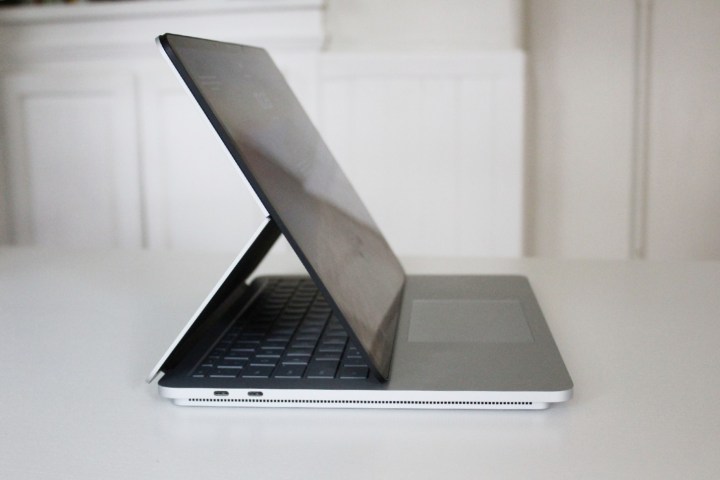
While the Surface Laptop Studio opens and closes like any other laptop, Microsoft couldn’t help but also integrate some wacky, 2-in-1 modes. When open, the bottom half of the lid can be pulled forward into “Stage Mode.” It magnetizes to the keyboard deck, leaving the touchpad available for use but the keyboard covered. This has shown up in other laptops, such as the leather-bound HP Elite Folio. It bears the most resemblance to the Acer ConceptD Ezel laptops, which also had a pull-down “Stage Mode” of sorts.
The implementation on the Surface Laptop Studio, however, is the best attempt at making this type of hinge work smoothly. While it does often involve using two hands, converting the device from one mode to another feels fluid and simple. The magnetic attachments feel secure, and they guide the movement of the hinge.
Once you know what’s possible, it feels every bit as natural as other 2-in-1 devices like the Surface Pro 8 or the iPad Pro. Unlike the ConceptD Ezel, you’re not meant to use the Surface Laptop Studio in the stages in-between the different modes. That means it’s more limited, yes, but it feels sturdier.
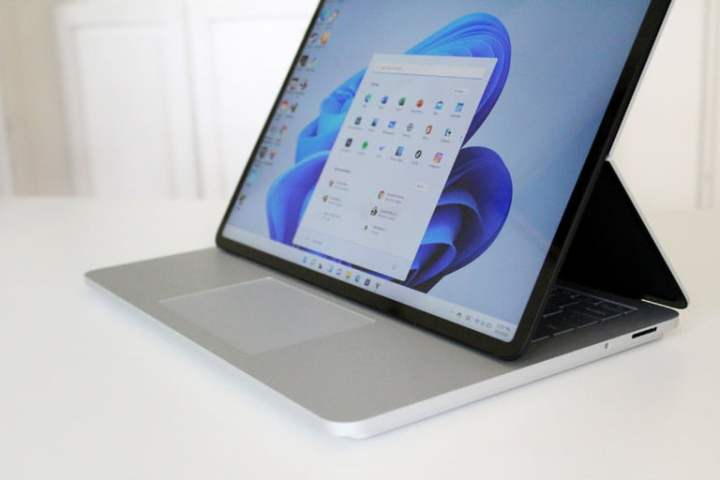
So, what’s Stage Mode good for? Well, Microsoft imagines that you’ll spend most of your time illustrating painterly masterpieces with the Surface Pen. That might be true for you, but I’m not an artist or a designer. And yet, I found plenty of instances where Stage Mode was handy. We all know that touchscreens on laptops aren’t comfortable for long periods of time. Reaching up and touching your pointer finger to a laptop screen is (and always has been) an ergonomic nightmare. Jabbing the screen with your finger also results in wobbling lids.
Stage Mode fixes both of those problems. The angle is more comfortable for touch use, whether with your finger or the Surface Pen, and it’s much more sturdy than in laptop mode.
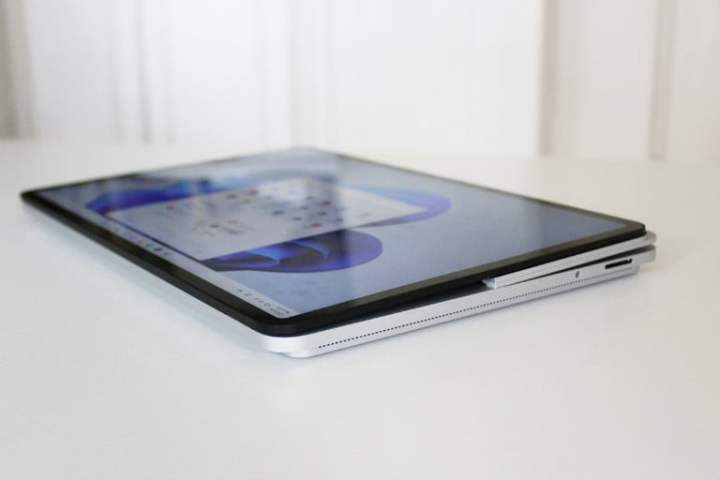
There is also “Studio Mode,” which is a bit less useful. The screen can fold down almost flat on top of the keyboard. Here you’re left exclusively with the touchscreen as your main input. Due to the weight of the device, you likely won’t be using this as a “tablet,” so to speak. Because of that, Studio Mode is primarily for dedicated time with the Surface Pen, whether that’s working in Illustrator or writing notes in Whiteboard while holding it like a clipboard. I’ll fully admit that artists may appreciate Studio Mode more than I did.
Lastly, you can also flip the screen all the way around, facing away from the keyboard. This mode is great for watching movies or gaming with an external controller. The speakers represent a problem with this mode, however, as they are pointing completely away from you.
The best part about these modes, though, is how easy it is to ignore them. If all you wanted was a Surface Laptop with an RTX graphics card inside, the Surface Laptop Studio doesn’t sacrifice too much to make its experimental hinge function.
Display
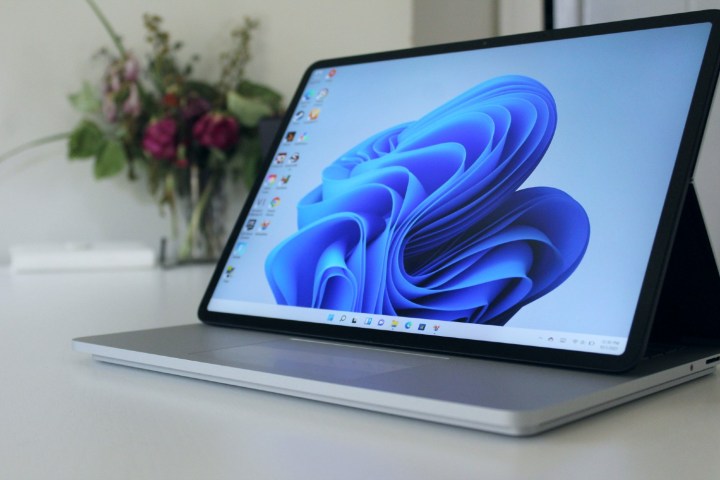
The Surface Laptop Studio has a marvelous display. It’s easily the best screen Microsoft has put in a Surface device outside of the Surface Studio all-in-one, regardless of what metric you’re testing it by. The 14.4-inch screen has a 3:2 aspect ratio (of course), with a resolution of 2400 x 1600. That’s 197 pixels per inch (ppi), which isn’t quite as sharp as the 227 ppi of the MacBook Pro 13-inch or the 290 ppi of the 4K Dell XPS 15. Still, the screen feels plenty sharp for its size.
The Surface Laptop Studio, though, has an upper hand against both of those laptops with its 120Hz refresh rate. Refresh rates over 60Hz have long been reserved for only gaming laptops, but the Surface Laptop Studio (and Surface Pro 8) are finally bringing the benefit of ultrasmooth animation to the non-gaming world. Once you spend time on a 120Hz screen, especially in Windows 11, you won’t want to go back.
Of course, the Surface Laptop Studio can also make use of that refresh rate in games, which makes it a more legitimate gaming laptop compared to the Dell XPS 15, Asus Vivobook Pro 16X, the MacBook Pro, or the Acer Swift X.
Once you spend time on a 120Hz screen, you won’t want to go back.
The display of the Surface Laptop Studio also has fantastic image quality. Apart from the Surface Studio, the Surface Laptop Studio has Microsoft’s brightest screen, with a max of 443 nits. There are brighter screens out there, but it closely matches what Apple currently offers in its MacBook Pros and feels plenty bright, even while working outside or next to a window.
The color gamut reaches 100% sRGB and 82% AdobeRGB. That’s not perfect like some 4K laptops — the Dell XPS 15 or HP Spectre x360 come to mind. But combined with the Delta-E of 1.3, this is a display that’s qualified for serious creative work. These results were all achieved in the defaulted “Vivid” color profile. The option for the “sRGB” color mode has a narrower color gamut and worse color accuracy.
Ports

Thunderbolt 4 coming to the Surface Laptop Studio is a big deal and makes it competitive. The Surface Laptop Studio features two of these USB-C Thunderbolt 4 ports on the left side. On the right, you’ll find a Surface Connect dock and a headphone jack.
Despite the quality of these ports, the amount of them is worrying. I won’t waste your time bemoaning the lack of USB-A and HDMI, but it certainly would have been nice to have another USB-C port and even an SD card slot. Not requiring an adapter to upload content straight from a camera would have been a great convenience for the target audience of this laptop, and it’s something the XPS 15 includes.
Microsoft is following the lead of Apple here, which offers just two Thunderbolt 4 ports on its M1 MacBook Pro. But if the rumors about the upcoming 14-inch redesign turn out to be true, the decision to cut legacy ports could end up being a bit retrograde.
Webcam and speakers
The webcam has a 1080p resolution, which is certainly a step up from the Surface Laptop 4, XPS 15, or other 720p laptops. It’s not, however, quite as crisp or smooth as the Surface Pro 8. The Surface Laptop Studio, of course, also has an IR camera in the top bezel
The device uses a quad-speaker setup — two under the keyboard, and two subwoofers on the sides of the laptop. The result is a pleasant balance of audio that is a solid upgrade over the Surface Laptop 4. But again, the Surface Pro 8’s powerful forward-facing speakers run circles around these speakers, as do the MacBook Pro’s.
Performance

The promise of a truly “pro”-level Surface device has been a long time coming. The Surface Book 3 got close, but it didn’t quite have the performance and display quality needed to please creative professionals.
The Surface Laptop Studio attempts to do two things to improve over the performance limitations of the Surface Book 3. First, it uses a slightly more powerful Intel processor than the Surface Book, Surface Pro, or Surface Laptop lines use. The Core i7-11370H is a 35-watt, rather than 25-watt, chip. More power is always a good thing, and it ensures improved CPU performance over the Surface Book 3. Improved multi-core performance is key to improved performance in all types of creative and engineering tasks, and that’s the exact type of workflow the Surface Laptop Studio is targeting.
However, 8-core, 45-watt CPUs in laptops like the Dell XPS 15, MacBook Pro 16-inch, and plenty of others will always have the upper hand over the Surface Laptop Studio.
Microsoft says it built its own custom framework for managing the amount of power shared by the CPU and GPU, and insisted that this 35-watt CPU was the best solution. In many synthetic benchmarks, the Surface Laptop Studio’s performance is underwhelming. As expected, laptops like the Dell XPS 15 offer better single-core and multi-core performance across the board.
| Geekbench 5 (single/multi) |
Cinebench R23 (single/multi) | Handbrake (seconds) | PCMark 10 | Pugetbench Premiere Pro | 3DMark Time Spy | |
| Surface Laptop Studio (Core i7-11370H) | 1321 / 5131 | 1304 / 5450 | 179 | 5091 | 417 | 4266 |
| Lenovo ThinkPad X1 Extreme Gen 4 (Core i7-11800H) | 1520 / 7353 | 1519 / 10497 | 106 | 6251 | 432 | 6691 |
| Dell XPS 15 (Core i7-11800H) | 1556 / 7692 | 1513 / 9979 | 103 | 6024 | 509 | 4540 |
| Acer Swift X (Ryzen 7 5800U) | 1287 / 6663 | 1437 / 10135 | 99 | 6247 | 333 | 4073 |
| Asus Vivobook Pro 16X (Ryzen 9 5900HX) | 1544 / 8299 | 1486 / 11478 | 90 | 6486 | 571 | 4601 |
The struggling processor is highlighted most in Handbrake, which singles out the CPU performance for a real-life test. Without the aid of the discrete GPU, which is the second the Surface Laptop Studio uses to fix performance limitations, it lags behind the competition in a simple video encoding test, showing the limitations of the quad-core processor. Surprisingly, the processor performance alone isn’t all that much faster than the Surface Pro 8.
But again, Microsoft emphasizes the whole package here — real-life performance that can balance the power between CPU and GPU. Though it shares a lot in common with Nvidia’s Dynamic Boost technology, Microsoft’s own framework here is homegrown. Microsoft says the system dynamically allocates both power (up to 50 watts for the RTX 3050 Ti) and fan speed, making moment-by-moment decisions to manage both the CPU and GPU.
The PugetBench Premiere Pro benchmark is good proof for that claim, as it tests a number of video editing tasks that use both components.
Here, the Surface Laptop Studio certainly does better than in CPU-bound tests and benchmarks. For example, the Dell XPS 15 is 33% faster in multi-core Cinebench performance, but just 15% faster in PugetBench. So, while the Surface Laptop Studio’s CPU is still holding back performance, the system undoubtedly does a good job of balancing the system’s power sharing.
Compared to similar laptops, the performance of the Surface Laptop Studio sits in the middle of the road.
Compared to laptops with a similar mix of components, though, the Surface Laptop Studio sits in the middle of the road in terms of its PugetBench performance. The fastest RTX 3050 Ti content creation laptop that I’ve tested is the Asus Vivobook Pro 16X, which uses a Ryzen 9 5900HX.
Gaming is also a good test of overall performance and power sharing. Not surprisingly, the Surface Laptop Studio performs admirably in more GPU-heavy games, and struggles in titles that lean more on CPU performance. You see that in a game like Civilization VI, which depends heavily on the CPU for fast frame rates, especially in lower resolutions and graphics settings. At 1920 x 1200 and Medium settings, the Surface Laptop Studio is still fast at 105 frames per second, but significantly behind the Asus Vivobook Pro 16X and Dell XPS 15. That comparison evens out at higher resolutions.
Throughout it all, the Surface Laptop Studio handles internal temperatures well, never spiking over 82 degrees Celsius for either the CPU or GPU. Surface temperatures did get warm, and even sometimes in the right palm rest. It’s not as egregious as the Razer Blade laptops, but you’ll definitely feel temperatures rise across the entire device when heavy tasks are being performed.
Keyboard and touchpad
To my surprise, there have been very few attempts to recreate the MacBook Pro’s Force Trackpad on a Windows laptop. None have come close. Then, the Surface Laptop Studio comes along and outdoes it. This is officially my favorite touchpad on any laptop, surpassing the MacBook Pro and the more conventional Surface Laptop 4.
First, the tracking and gesture support is second to none. The glass surface is incredibly smooth, the palm rejection is accurate, and it’s plenty large. The haptic feedback system, though, is where things really get fun.

From what Microsoft has said, it uses a similar haptic motor as the Force Trackpad, simulating the feeling of depressing a button. Microsoft’s implementation is even more convincing, and the ability to customize its sensitivity is the cherry on top. I found the sweet spot to be around 75%, but cranking it up to the max is really close to fooling your brain into thinking it’s a physical click.
Microsoft performed a similar miracle with its Surface Slim Pen 2, which uses subtle haptic feedback in the stylus to simulate the feeling of friction. Although the Surface Slim Pen 2 doesn’t come bundled with the Surface Laptop Studio, it’s a fantastic supporting peripheral.
The keyboard isn’t nearly as adventurous, but is no less enjoyable. The choice of gray keycaps instead of black is a nice change-up (and keeps it from looking like a MacBook ripoff.)
Meanwhile, the keypresses feel similar to the Surface Pro 8’s Type Cover — precise, with plenty of travel and a comfortable bottoming action. The size and layout of the keyboard is also nearly identical to the Surface Pro 8 Type Cover, the only change being the power button being squeezed into the function row. I wouldn’t have minded an expanded keyboard with larger keycaps, but I immediately felt at home on this keyboard.
Like all Surface devices, the Surface Laptop Studio does not include a fingerprint reader, instead relying on the Windows Hello functionality in the IR camera.
Battery life
I was pleasantly surprised by how long the Surface Laptop Studio lasts on a single charge. Despite having a high-resolution screen (with a high refresh rate) and discrete RTX graphics, I didn’t have a problem using the Surface Laptop Studio through the majority of a workday away from an outlet.
I tested the battery by cycling through a series of heavy websites until the battery died. The Surface Laptop Studio lasted over 10.5 hours in this test, which outlasts both the Dell XPS 15 (4K OLED) and Surface Book 3. The Surface Laptop Studio has strong battery life, but champions like the Asus Vivobook Pro 16X last over 16 hours in this same test.
You can get as much as 14 hours out of the Surface Laptop Studio in extremely light tasks, such as in our video playback test, which cycles a local 1080p clip until the battery dies. I never got quite up to the 18 hours claimed by Microsoft, but for a laptop of this size and performance level, I can’t complain.
Configurations and price
Like the Surface Book 3, the Surface Laptop Studio starts at $1,600. That base configuration, though, isn’t one that will likely attract many buyers. Though it has 16GB of RAM, it doesn’t have a discrete graphics card, and with the limitations of the CPU already explained, that leaves the $1,600 and $1,800 models a bit underpowered.
As always, Microsoft charges an awful lot for upgrades. It costs an extra $600 to go from 16GB to 32GB of RAM and 512GB to 1TB in storage. That’s $200 more than Apple charges for the same upgrades (and $100 more than Dell charges)! That makes the $2,100 configuration a solid option, especially since you can upgrade your SSD for more if you really want. It is, actually, a few hundred bucks cheaper than the Surface Book 3 in the higher-end options.
And don’t forget — the Acer Swift X is $1,000 cheaper than the Surface Laptop Studio, despite having very similar components.
When storage and memory is matched, the Surface Laptop Studio comes in at $500 more expensive than the M1 13-inch MacBook Pro. The Surface Laptop Studio is, of course, upward of $500 cheaper than the Intel-powered MacBook Pro, though that is soon to be replaced.
Our take
The Surface Laptop Studio isn’t perfect — its weakened quad-core processor is a problem. If you’re someone who really needs that performance more than anything, there are more powerful options out there.
You have to buy into the overall vision of the product to make the Surface Laptop Studio worth its price. The different 2-in-1 modes, the integration with the Surface Slim Pen 2, the haptic feedback touchpad, and the gorgeous 120Hz screen are all things that make the Surface Laptop Studio unlike any other laptop you can buy right now.
Are there any alternatives?
The Razer Blade 14 matches (or exceeds) much of what the Surface Laptop Studio does in terms of performance, size, and premium feel. It doesn’t have the pull-forward hinge or stylus support, of course, but the option for up to an RTX 3080 and the eight-core Ryzen 9 5900HX make it a more powerful laptop.
Much about the upcoming M1X MacBook Pro 14-inch is unknown, though it will certainly be the primary rival to the Surface Laptop Studio once it launches later this year.
The Dell XPS 15 is also a good alternative. You can’t compare it directly with the Surface Laptop Studio due to its different screen, but both laptops can be configured with the RTX 3050 Ti and are similarly powerful creative laptops.
How long will it last?
The Surface Laptop Studio should last many years — hopefully as many as five or six. The processor and graphics card will no doubt start to feel old after a few years, but the ability to upgrade the storage yourself — all the way up to 2TB — is helpful
Should you buy it?
Yes. The Surface Laptop Studio provides a unique 2-in-1 laptop you can’t get anywhere else.
Editors' Recommendations
- Surface Pro 10: all the major changes rumored for the new model
- 9 best 2-in-1 laptops in 2024: tested and reviewed
- Best 14-inch laptops for 2024: tested and reviewed
- 9 best laptops of 2024: tested and reviewed
- The best 2-in-1 gaming laptops for 2024


